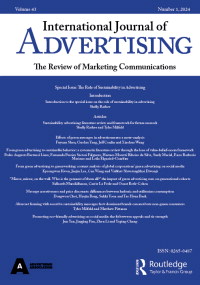Getting sentimental about the need for more research on nostalgia in advertising
IF 5.9
3区 管理学
Q1 BUSINESS
引用次数: 0
Abstract
This year’s Super Bowl, advertising’s ‘big moment’ in the U.S., with average viewership exceeding 100 million, saw very heavy use of ‘A’ list celebrities coupled with humor. This combination was so prevalent as to be almost formulaic (Taylor 2023). That said, advertisers using this formula did make significant effort to stand out and one way to do this was via the use of nostalgic appeals. For example, John Travolta sang in an ad for T-Mobile based on ‘Grease’, and send-ups of old popular movies such as Clueless and Caddyshack that have cross-generational appeal made an appearance. Interestingly, we saw some new angles on nostalgia as well, at least in the context of the Super Bowl. For example, Popcorners’ ad was a parody of the popular television series ‘Breaking Bad’, featuring the original starts of the series that ran from 2008-2013. In addition, at least a few advertisers, including Uber One and Budweiser used appeals based on more recent music, but music that appeals to people of all ages. In Uber One’s case, rapper Diddy drew on hit songs mainly from the 1990s and 2000s that were popular in the formative years of younger consumers but known to older consumers as well. In contrast, Workforce’s ad featured aging rockers including Ozzy Osbourne, Joan Jett, and Paul Stanley of Kiss, each of whom has some level of popularity across ages.需要对广告中的怀旧情绪进行更多的研究
今年的超级碗是美国广告的“重要时刻”,平均收视率超过1亿,大量使用了“A”名单上的名人和幽默。这种组合非常普遍,几乎是公式化的(Taylor 2023)。也就是说,使用这个公式的广告商确实做出了巨大的努力来脱颖而出,其中一种方法是使用怀旧的吸引力。例如,约翰·特拉沃尔塔(John Travolta)在T-Mobile的一则基于《油脂》(Grease)的广告中演唱,《无线索》(Cluless)和《Caddyshack》(Caddyshak)等具有跨代吸引力的老电影也出现了。有趣的是,我们也看到了一些关于怀旧的新角度,至少在超级碗的背景下是这样。例如,Popcorners的广告是对流行电视剧《绝命毒师》的模仿,以2008-2013年该剧的最初开头为特色。此外,包括优步一号(Uber One)和百威(Budweiser)在内的至少一些广告商使用了基于最近音乐的吸引力,但音乐吸引了所有年龄段的人。在优步一号的案例中,说唱歌手Diddy主要借鉴了20世纪90年代和21世纪初的热门歌曲,这些歌曲在年轻消费者的成长期很受欢迎,但老年消费者也很熟悉。相比之下,Workforce的广告中有一些上了年纪的摇滚歌手,包括Ozzy Osbourne、Joan Jett和Kiss的Paul Stanley,他们每个人在不同年龄段都有一定的人气。
本文章由计算机程序翻译,如有差异,请以英文原文为准。
求助全文
约1分钟内获得全文
求助全文

 求助内容:
求助内容: 应助结果提醒方式:
应助结果提醒方式:


